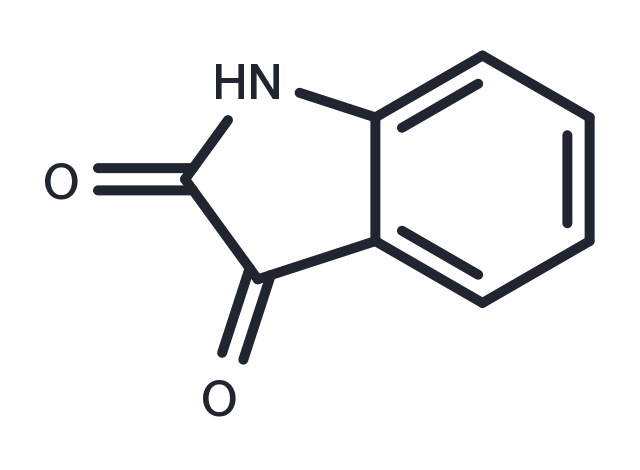Powder: -20°C for 3 years | In solvent: -80°C for 1 year


Isatin (2,3-Indolinedione) is an endogenous MAO inhibitor.

| Pack Size | Availability | Price/USD | Quantity |
|---|---|---|---|
| 500 mg | In stock | $ 29.00 | |
| 1 mL * 10 mM (in DMSO) | In stock | $ 29.00 |


| Description | Isatin (2,3-Indolinedione) is an endogenous MAO inhibitor. |
| Targets&IC50 | MAO-A:58 μM, MAO-B:14 μM, MAO:15 μM |
| In vitro | Isatin induces apoptosis of MCF-7 cells. Bcl-2 expression is decreased and the ratio of Bcl-2 to Bax is significantly decreased by isatin. The mitochondrial transmembrane potential is markedly decreased and the release of cytochrome c into the cytosol is elevated following treatment with isatin. At the same time, caspase-9 and -3 are stimulated, followed by the degradation of ICAD, a caspase-3 substrate. Isatin and its analogs inhibits the proliferation of some cancer cells, including colon HT29, breast MCF-7, lung A549 and melanoma UACC903 cells and is a dual inhibitor of tubulin polymerization and the Akt pathway[4]. |
| In vivo | Isatin is an endogenous indole that is increased in stress, inhibits monoamine oxidase (MAO) B and improves bradykinesia and striatal dopamine levels in rat models of Parkinson's disease. Isatin has a distinct and discontinuous distribution in rat brain and other tissues; the highest concentrations in the brain are found in the hippocampus and cerebellum. In rodent models isatin has been shown to cause a widespectrum of dose-dependent physiological and biological actions, such as anxiogenic and sedative effects, memory dysfunction and inhibition of food and water intake. Significantly, isatin readily crosses the blood-brain barrier so that a peritoneal dose of 100 mg/kg would result in a concentration of about 120 μM in the rat brain. This concentration would increase further with repeated injections[2]. |
| Cell Research | Cell viability was estimated by a colorimetric method, which is based on the ability of cellular dehydrogenases of viable cells to reduce MTT from a yellow watersoluble dye to a dark blue insoluble formazan product. SHSY5Y cells were seeded in 96-well plates at 4×104 cells/well/(100 ml) and allowed to attach. The cells were then treated with isatin and returned to the incubator for 24 or 48 h. MTT 25 μl (5 mg/ml) was added to all wells and allowed to incubate in the dark at 37℃ for 2 h followed by cell lysis. The plates were read with an OPTImax microplate reader at wavelength of 562 nm. Controls included untreated cells and medium alone, with all MTT assays performed in triplicate.(Only for Reference) |
| Source |
| Synonyms | Pseudoisatin, Indoline-2,3-dione, 2,3-Indolinedione |
| Molecular Weight | 147.13 |
| Formula | C8H5NO2 |
| CAS No. | 91-56-5 |
Powder: -20°C for 3 years | In solvent: -80°C for 1 year
Ethanol: 10 mg/mL (67.96 mM)
H2O: < 1 mg/mL (insoluble or slightly soluble)
DMSO: 28 mg/mL (190.3 mM)
You can also refer to dose conversion for different animals. More
bottom
Please see Inhibitor Handling Instructions for more frequently ask questions. Topics include: how to prepare stock solutions, how to store products, and cautions on cell-based assays & animal experiments, etc.
Isatin 91-56-5 Apoptosis Metabolism Neuroscience Monoamine Oxidase MAO Inhibitor Pseudoisatin Indoline-2,3-dione 2,3-Indolinedione inhibit inhibitor
